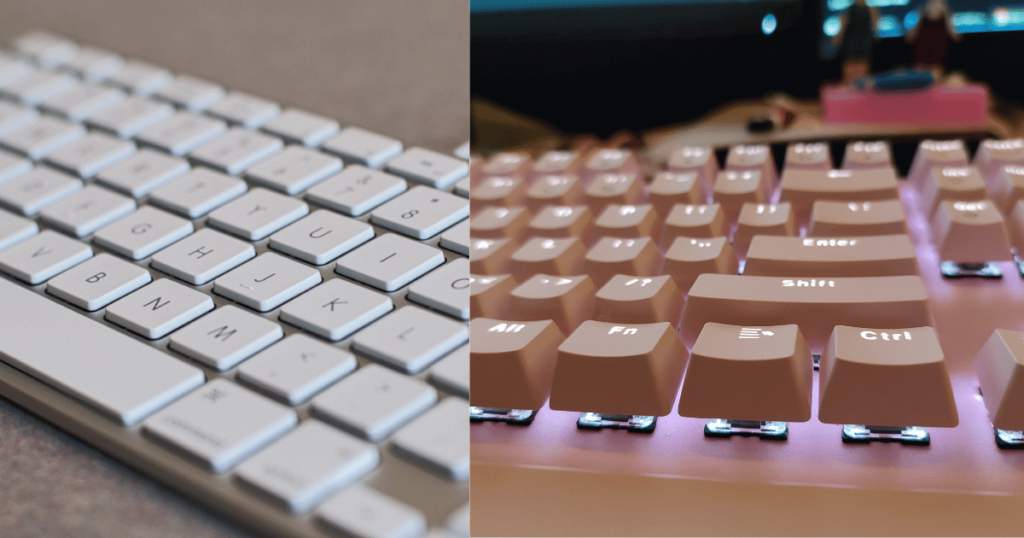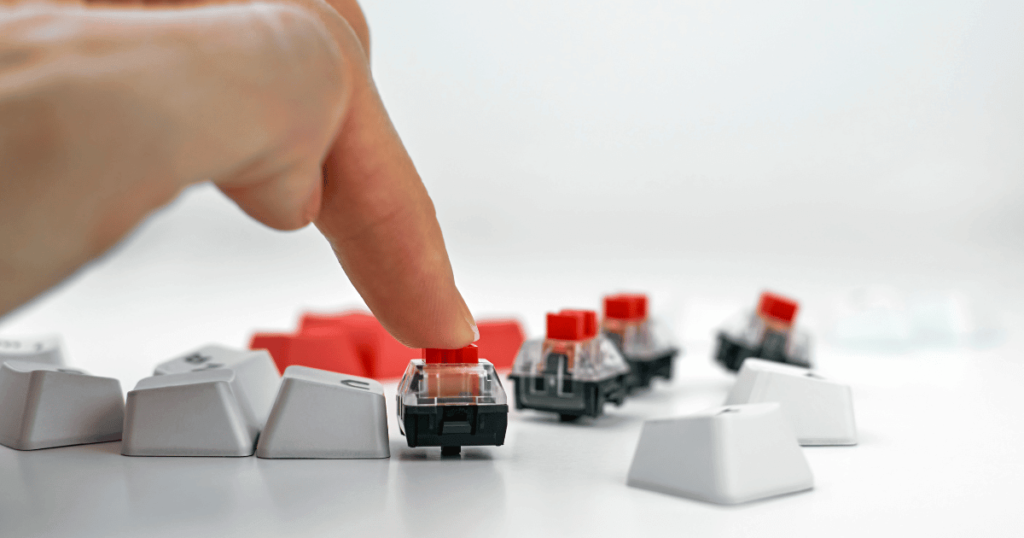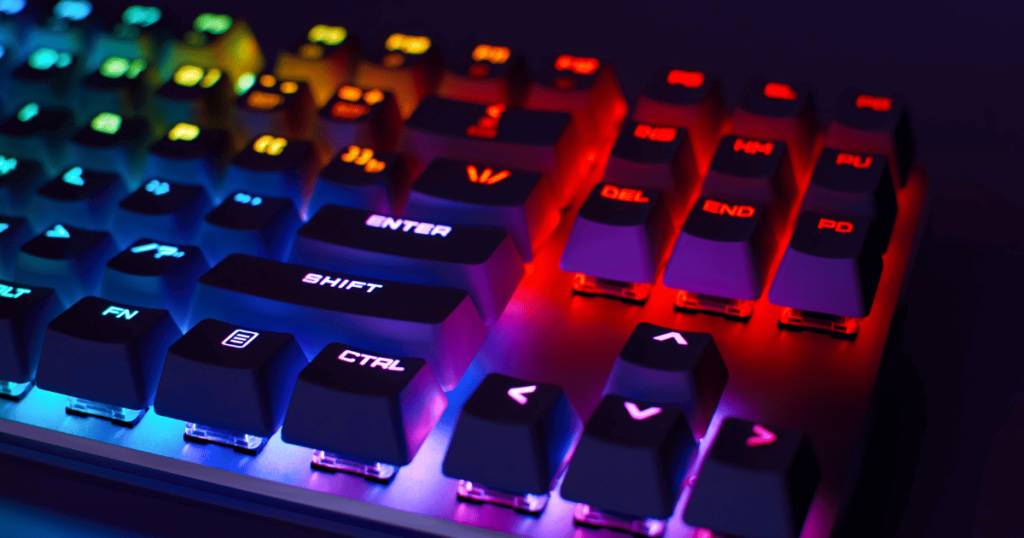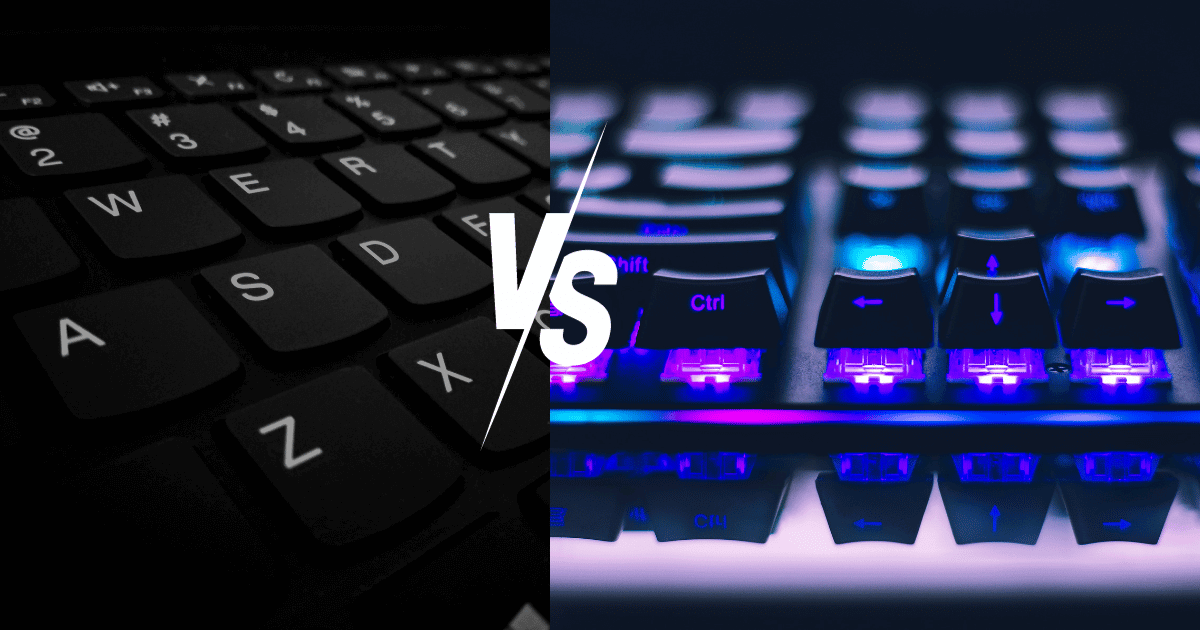When you’re picking out a keyboard, deciding between a low-profile and a normal-profile keyboard is a big choice. This article will help you understand the differences between these two types of keyboards.
We’ll look at how they feel when you type, how easy they are to carry around, and what they’re like to use every day.
Whether you use your keyboard for gaming, work, or just browsing the internet, this guide will help you figure out which keyboard is best for you.
Key Takeaways:
- Shorter keycaps and shallower switches in low-profile keyboards enable quicker typing, contrasting with the taller keycaps and deeper switches of normal-profile keyboards for a traditional feel.
- Lower actuation force and shorter travel distance in low-profile keyboards facilitate faster typing, while normal-profile keyboards, with higher force and longer travel, offer a distinct typing experience.
- Low-profile keyboards tend to be slightly quieter, whereas normal-profile keyboards often have a more noticeable ‘clicky’ sound.
- Low-profile keyboards are easier to clean but may be less durable, in contrast to more robust but higher-maintenance normal-profile keyboards.
- Normal-profile keyboards have a wider variety of switch options compared to low-profile keyboards.
Design Differences
Keycap Height

Low-profile keyboards often start with keycap heights as low as 2mm, offering a sleek appearance and potentially quicker typing. For instance, at the time of writing this article, I’m using a low-profile keyboard from Redragon with keycaps that are around 5mm tall.
On the other hand, normal profile keyboards typically have taller keycaps, sometimes up to 17mm, which gives a more traditional typing feel and tactile feedback.
This difference in keycap height affects overall ergonomics and user preference.
Switch Depth
The switch depth in low-profile keyboards is shallower, contributing to the keyboard’s slim profile and potentially quicker key presses. These switches are about 35%–40% shorter than those in normal profile keyboards, which feature deeper switches.
This results in a more pronounced and tactile keypress experience, influencing the overall typing feel and speed.
Keyboard Thickness

Low-profile keyboards are typically thinner, enhancing portability and potentially offering more comfort by reducing wrist strain during use. For instance, the low-profile Redragon keyboard that I mentioned above is about 17mm thick.
On the other hand, normal profile keyboards are generally thicker, which can provide a sense of stability and robust build quality, which is preferred by users who prioritize a solid typing platform.
Mechanical Differences
Actuation Force and Travel Distance

The actuation force, the pressure needed to register a keypress, is lower in low-profile keyboards, typically around 45–50 g. They also feature a shorter travel distance of 1.2 to 1.7 mm, leading to faster typing and reduced finger strain.
In contrast, normal profile keyboards often require a higher actuation force, about 50–70g, and have a longer travel distance, typically 2–3.5 mm.
This results in keys with a more substantial feel, potentially providing a more satisfying typing experience for those who prefer more pronounced feedback.
Sound Profiles

Sound plays a big role in the typing experience. Low-profile keyboards generally have a quieter sound profile, making them a considerate choice in shared spaces or for those sensitive to noise.
Normal profile keyboards, on the other hand, are known for their louder, more distinctive ‘clicky’ sound. While this can be disruptive in quieter environments, many users find the auditory feedback satisfying and an integral part of their typing rhythm.
Ergonomics and Comfort
The profile of a keyboard, low or normal, greatly affects wrist and hand posture, impacting comfort during extended use.
Low-profile keyboards typically allow for a more natural hand position, reducing wrist strain. This can be a real plus for long typing sessions.
Conversely, normal profile keyboards may require adjusting wrist posture due to their taller keys, potentially increasing strain for some users.
However, it’s important to note that comfort is highly subjective; what feels comfortable for one person may not be ideal for another.
Finding the right keyboard is about striking a balance between ergonomic benefits and personal comfort, ensuring it supports not just efficient typing but also overall physical well-being.
Performance and User Experience

In terms of performance and user experience, choosing between low-profile and normal-profile keyboards depends heavily on individual needs and preferences. Having transitioned from a normal profile membrane keyboard to a Redragon low profile mechanical keyboard, I noticed significant differences in typing and gaming.
For typing, the low-profile keyboard enhances productivity. Its reduced key height and lower actuation force ease hand fatigue, allowing for longer, more comfortable typing sessions. The keys respond quickly to light touches, making typing smooth and efficient.
In gaming, however, the experience differs. While the low-profile keyboard performs well, its sensitivity, beneficial for typing, can be a drawback in competitive gaming.
Initially, I often pressed buttons accidentally due to the lighter keypress required. Over time, while I’ve adapted and reduced these errors, they still occasionally happen.
Durability and Maintenance
Durability and maintenance vary between low-profile and normal-profile keyboards. Low-profile models typically use lighter materials to achieve their sleek design, potentially impacting durability. However, their simpler construction can make cleaning and maintenance easier.
Normal profile keyboards often have a more robust build, using sturdier materials that can withstand extensive use. This robustness can contribute to a longer lifespan but may require more effort in maintenance.
Both types have their trade-offs in terms of material quality, construction durability, ease of maintenance, and overall lifespan.
Portability and Space Requirements

When considering portability and space, low-profile and normal-profile keyboards mainly differ in height, not overall footprint.
Low-profile keyboards, being slimmer, are easier to transport, making them a great choice for mobile setups or those who frequently change their workspaces. Their sleek design also fits well in minimalist setups, adding to the aesthetic without dominating the space.
Normal profile keyboards, while similar in footprint, are bulkier due to their height, making them less convenient for frequent transportation but potentially more suitable for permanent, stationary setups where mobility isn’t a priority.
Customization and Aesthetics

When it comes to customization and aesthetics, while both low-profile and normal-profile keyboards offer various options, there’s a notable difference in the range of available switches.
Normal profile keyboards generally have a wider selection of switches, giving users more choices to fine-tune their typing experience. This variety allows for greater customization in terms of tactile feel and sound.
On the other hand, low-profile keyboards, though increasingly versatile, tend to have fewer switch options.
However, they excel in their sleek design and can be a great choice for those who prioritize a minimalist aesthetic.
Both types offer RGB lighting and different design themes, enabling users to personalize their setup visually.
Frequently Asked Questions
Are low-profile keyboards good for gaming?
Yes, low-profile keyboards can be good for gaming. They often offer quicker response times and reduced key travel, which can enhance performance in fast-paced games. However, some gamers may need time to adjust to the lighter keypress.
Can the keyboard profile affect typing speed or accuracy?
Yes, the profile of a keyboard can impact typing speed and accuracy. Low-profile keyboards, with their shorter key travel and lower actuation force, can lead to quicker typing. However, this depends on the user’s typing style and comfort with the keyboard.
Is there a difference in maintenance and durability between low and normal-profile keyboards?
The difference in maintenance and durability between the two types is not significant. Low-profile keyboards may be easier to clean due to their flatter design, but normal-profile keyboards often have a more robust build. Both types require regular maintenance for optimal performance.
Conclusion
As we’ve explored the distinct features of low-profile and normal-profile keyboards, it’s clear that each has its unique strengths and suits different preferences.
From typing comfort to gaming performance, the choice can significantly affect your daily computer use.
We’d love to hear from you – which type of keyboard do you prefer and why? And are you team membrane or mechanical keyboards? Share your experiences and preferences in the comments below.
We're an affiliate
We hope you love the products we recommend! Just so you know, gameraround.com is a participant in the Amazon Services LLC Associates Program, an affiliate advertising program designed to provide a means for sites to earn advertising fees by linking to Amazon.com.

